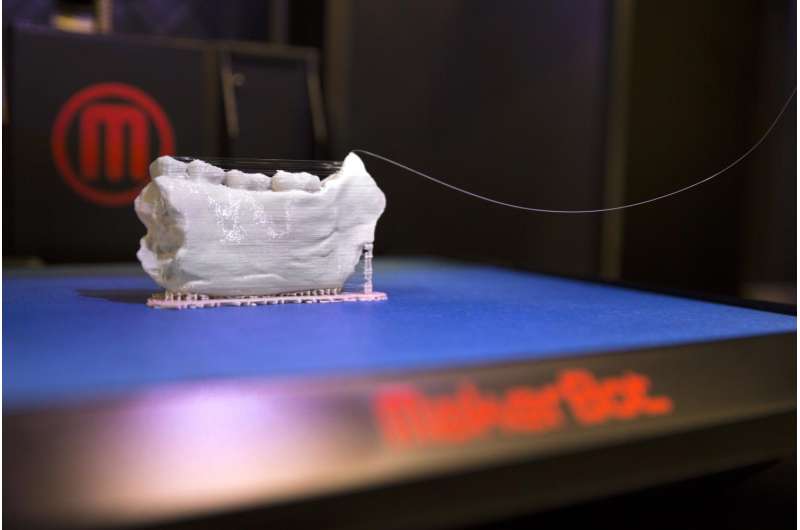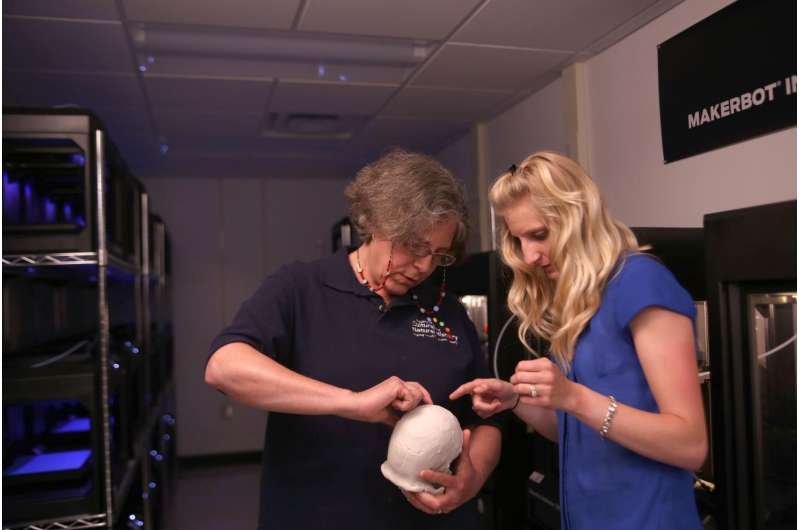Student uses 3-D printers to recreate and date fossils of new human species

More than 8,500 miles away from where scientists still are analyzing fossils discovered in a South African underground cave in 2013, Central Michigan University anthropology student Jennifer Webb holds an exact replica of one of the fossils.
Printed on a 3-D printer on campus, it is one of approximately 10 replicas Webb will produce this summer. She is working to help identify the affinities of Homo naledi—a new member of the human family tree that could be well over two million years old.
Webb believes Homo naledi may be much younger than this estimation. Her hypothesis rests on how the fossils were found: the bodies were mass buried, which could indicate socialization behaviors different than those of earlier humans.
"If the species turns out to be around 2 million years old, then it will be the earliest appearance of the Homo genus that demonstrates such primitive morphology and ritualized behavior at the same time," Webb said. "If it turns out to be closer to around 1 million years old or younger, it would mean that many different types of ancient humans coexisted at similar times in South Africa than was previously thought."
Webb uses digital scans of the fossils available in an online database and prints the fossil replicas in CMU's MakerBot Innovation Center—a large-scale 3-D printing installation that is the only one of its kind in the Midwest. The digital scans are made available to scientists worldwide through MorphoSource, a repository of hundreds of scans free to download and 3-D print.
"We are using these 3-D models of teeth from the Homo naledi fossils to do comparisons," Webb said. "I'm looking at the different physical characteristics and traits in the teeth, then comparing those to a species of a known time period. If you don't know the age of something, you have to compare it in both directions. That's our goal: to either rule it out or to determine if it's plausible."

Game-changing technology
CMU anthropologist Rachel Caspari, who is supervising Webb's research, said the ability to access scans of the Homo naledi fossils is state of the art and new to the anthropology field.
"Historically, it has taken up to 20 years for research to be published after a dig site is discovered," Caspari said. "These are young scientists, however, and they are doing things differently. By making the scans available online, others around the world can be a part of the research. It makes it more egalitarian and can make science work much better."
Webb said original casts of the remains are unavailable.
"The digital scans are available online for the species," Webb said. "That allows a lot of people to do research. Because we had that access, we thought 3-D printing would be a great alternative to casts."
Webb is examining the the affinities of the teeth. Of special interest is their relationship to a sample of early modern humans, about 100,000 years old, from the same region. The traits—such as resemblance of teeth from other regions or time periods—can help archeologists roughly determine the age of the teeth.
To do this, Webb studies the shape of the crown, the cusps, the number of roots, wear patterns and more. Webb said some molars have more cusps in certain geographical regions. Once all of the fossils are printed, she will score each trait and compare the Homo naledi fossils to other fossils with confirmed dates to determine how closely related they are.
"Bones are important because they tell stories," Webb said. "You learn to read what they are telling you based on the characteristics that you can look at and feel. It helps you understand things that happened to them in their past."
Provided by Central Michigan University





















